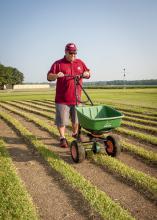Information Possibly Outdated
The information presented on this page was originally released on August 30, 2013. It may not be outdated, but please search our site for more current information. If you plan to quote or reference this information in a publication, please check with the Extension specialist or author before proceeding.
State's sod producers recover from slow start
MISSISSIPPI STATE -- This year’s rainy spring kept grass from growing, but it also kept contractors from building, allowing Mississippi’s sod farmers to manage the season’s rough beginning.
Barry Stewart, turf management specialist with the Mississippi State University Extension Service and Mississippi Agricultural and Forestry Experiment Station, said demand was low at a time that benefitted growers.
“As the year has gone on, we’ve warmed up and dried out. Construction is rolling along, and so is sod,” Stewart said. “The abundant rainfall has helped the farmers irrigate less but also has made it difficult at times to harvest sod.”
Mississippi turf growers rely on the versatile Bermudagrass for the bulk of their production but also cultivate Centipedegrass, Zoysiagrass and St. Augustine grass.
“The bread and butter grass for most farmers is some cultivar of hybrid Bermudagrass because it can be used on golf courses, athletic fields, home lawns and utility areas,” Stewart said. “Bermudagrass grows from rhizomes below the soil and stolons above the soil, so this grass spreads aggressively and has great recuperative potential. It’s easy to maintain, looks good and is hearty.”
Currently, about 47 growers produce about 4,500 acres of sod in the state. Stewart said this is down from the peak of about 70 growers with about 6,000 total acres. Some of these acres may have been harvested twice in one year to satisfy demand.
Sod farms are scattered across the state but are concentrated in higher numbers near larger markets, such as Memphis, Jackson, Tupelo and Hattiesburg.
Different species thrive in different growing conditions, and price usually has little to do with selection or demand, he said.
“Zoysia and St. Augustine demand the highest prices due to production inputs, length of time to produce and royalty fees, at about $2.75 to $3 per yard,” Stewart said. “Tifway Bermudagrass and Centipede are on the lower end at $1.50 to $2 per yard, which is slightly higher than recent years, but increased cost of production has lowered the profit margin.”
Stewart said so far this year, he has seen slightly less disease pressure and fewer insects than a typical year but more weed pressure, likely because of the wet conditions.
Dan Crumpton owns Oasis Sod Farms with farms in Coahoma and Copiah counties and a retail outlet at the Lakeland Lawn and Garden Center in Jackson.
This year, he said he has been playing catch-up.
“We had a wet spring, so we got a late start cutting in the southern part of the state,” he said. “We basically lost March and April, but we’ve been fairly busy since then.”
He said sod farming is a competitive business, with high inputs and prices that have not changed much over the course of his 16-year career.
“When prices are the same as they have been for years, but fertilizer prices have gone up significantly and diesel fuel is so high, it’s tough,” he said. “Overall, though, I think the outlook for the industry is decent. I’m slightly encouraged that the housing market is starting to turn. You could say I’m cautiously optimistic.”
A strong rate of new home construction would be a boon to the state’s turf growers, but with mortgage rates creeping up, the expected demand for sod may not materialize.
James Henderson, an Extension forest economics and management specialist, said the overall trend in new home construction is positive in spite of the fact that it leveled some over the summer to an annual rate of about 900 thousand units nationally.
“Many forecasts expect construction to return to the prerecession annual rate of 1.5 million during 2016,” Henderson said. “However, the recent increase in home mortgage interest rates over the last month may have a cooling effect on the rate of new home construction.”






